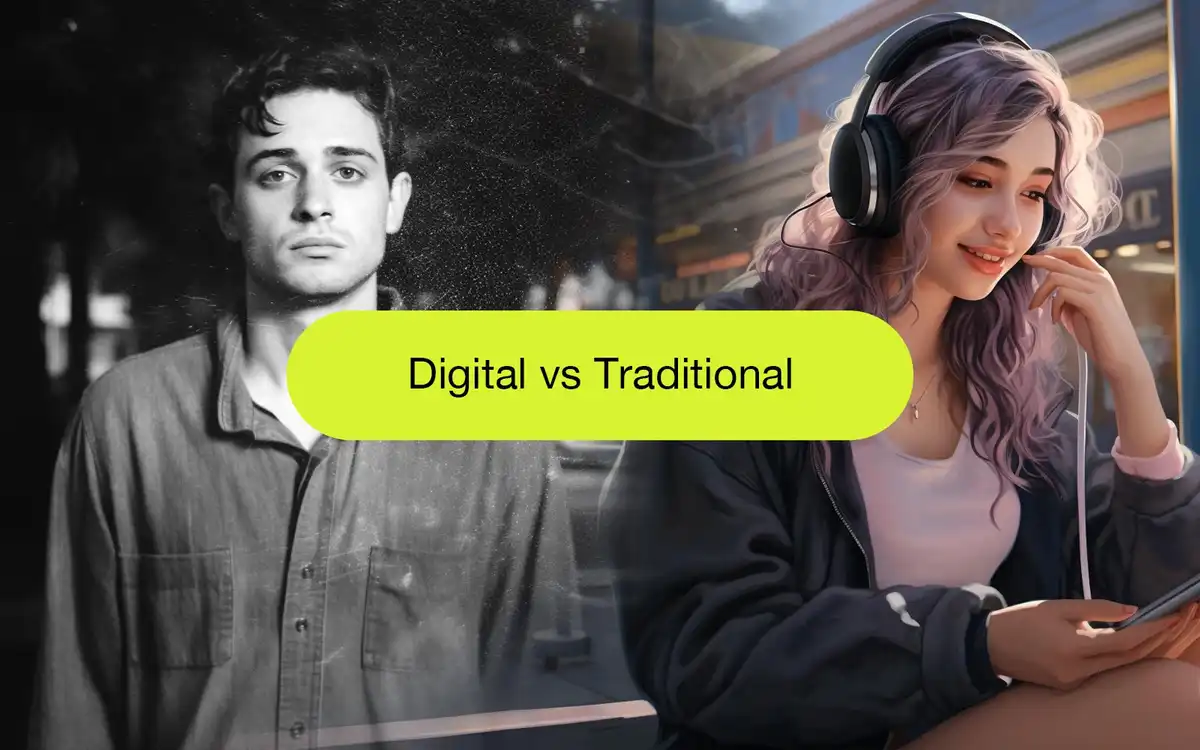Digital vs. Traditional Marketing: Which Should You Choose?

In an era where technology and consumer behaviour are inextricably intertwined, businesses face a crucial decision – will digital or traditional marketing lead them to market supremacy?
You would think that the answer is clearly digital, but the classic methods of traditional marketing are still effective. So it’s print, television, and radio against the dynamic and data-driven world of digital marketing. So, how do these two giants truly compare? What distinguishes them, and more importantly, which one should you wield in your marketing arsenal to achieve maximum impact and ROI? Let’s find out.
What is digital marketing?
Digital marketing leverages various digital channels, including websites and social media, as powerful tools for marketing communication. This approach recognises that the modern consumer is increasingly connected to the digital world, making online presence and engagement crucial for businesses.
Some of the ways digital marketing utilises these channels include:
- Websites: Digital marketing optimises websites to be user-friendly, informative, and visually appealing. Search engine optimisation (SEO) enhances the website’s visibility on search engines for organic traffic.
- Social Media: Social media platforms enable direct connection with a target audience. The real-time nature of social media allows for immediate feedback and engagement, helping to build brand loyalty and drive conversions.
- Email Marketing: Email marketing campaigns can include newsletters, promotions, product announcements, and personalised recommendations. Automation tools enable businesses to send relevant and timely messages to their subscribers, nurturing leads and driving sales.
- Search Engine Marketing (SEM): SEM encompasses paid advertising efforts, primarily through pay-per-click (PPC) campaigns on search engines like Google.
- Content Marketing: Content is at the heart of digital marketing. High-quality, relevant content is created to inform, entertain, or solve problems for the target audience.
Important note: Digital marketing relies heavily on data and analytics to measure campaign effectiveness. Marketers track key performance indicators (KPIs) such as website traffic, conversion rates, click-through rates, and social media engagement. This data-driven approach allows for continuously optimising marketing strategies to achieve better results.
What is traditional marketing?
Traditional marketing, also known as offline marketing, encompasses a range of promotional activities that rely on conventional channels and mediums to reach target audiences. Before the widespread adoption of the Internet in the 1990s, traditional marketing was the predominant and often the sole type of marketing.
Traditional marketing utilises the following channels:
- Printed Media: One of the cornerstones of traditional marketing, printed media included newspapers, magazines, brochures, flyers, and direct mail.
- Billboards: Billboards have long been a prominent feature of the urban landscape, providing advertisers with large, eye-catching displays to promote products, services, or brands.
- Television Advertising: Commercials are aired during popular TV shows or events, allowing them to engage a vast audience. The Super Bowl, for example, became famous for its high-profile and often creative commercials.
- Radio: Radio broadcasts allow advertisers to craft catchy jingles and scripts to promote their offerings to listeners.
- Outdoor Advertising: Beyond billboards, traditional marketing included other outdoor advertising methods, such as transit ads on buses and subway cars, as well as posters and banners at sports events and public spaces.
Companies also engage in traditional marketing by sponsoring or hosting trade shows, exhibitions, and sports events. This provided opportunities for face-to-face interactions with potential customers and enhanced brand visibility.
What’s the difference?
The primary difference between these marketing methods lies in the medium through which an audience encounters the message. This distinction fundamentally shapes how these approaches reach, engage, and influence their target audiences.
Digital marketing allows for high levels of interactivity. Audiences can directly engage with content, products, or services through digital channels. Traditional marketing, however, typically lacks the same level of interactivity. While there can be some interaction (e.g., calling a phone number from a print ad), it is often less immediate and dynamic than digital interactions.
Importantly, digital marketing often offers cost-effective solutions, particularly for small and medium-sized businesses. It allows for precise targeting, meaning marketers can reach specific demographics, interests, and geographic locations. The internet’s global reach makes connecting with a vast audience possible. Traditional marketing methods can be more costly; they have a broader reach but may lack the precision and targeting capabilities of digital marketing.
Which type should you use?
Achieving the right balance between traditional and digital marketing is often the key to a successful and impactful marketing campaign. Each approach has strengths and weaknesses, and a strategic blend can help businesses effectively reach and engage their target audiences.
Segments of your target audience likely prefer different channels. Younger demographics, for example, are more engaged with digital platforms, while older segments respond better to traditional methods. You can effectively reach a broader and more diverse audience by utilising both.
A balanced approach allows you to engage potential customers through multiple touchpoints. For example, someone might first discover your brand through a digital ad, visit your website or social media profiles, and later receive a direct mail or attend a physical event. This multi-channel strategy reinforces your message and builds brand recognition.
Find what suits your strategy
Traditional and digital marketing have distinct benefits, and the key to crafting a successful marketing strategy lies in understanding your specific needs, budget constraints, and, most importantly, comprehending your target audience.
Your marketing strategy should align with your specific objectives. Consider whether you want to build brand awareness, generate leads, drive sales, or achieve other goals. Traditional and digital marketing can excel in different areas, so choosing the right mix is essential.
Budget constraints play a significant role in determining your marketing approach. Digital marketing often offers more cost-effective options, but traditional marketing may still be viable with a well-considered budget. A successful marketing strategy considers these factors and crafts a tailored approach that leverages the strengths of each type of marketing to achieve the desired results.